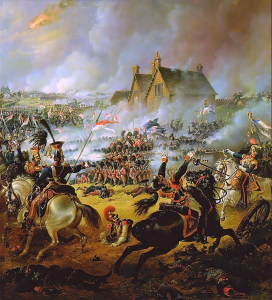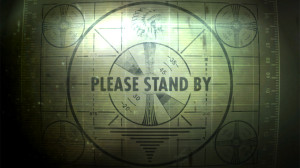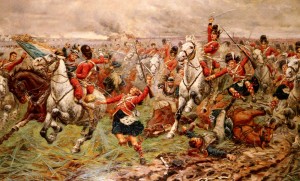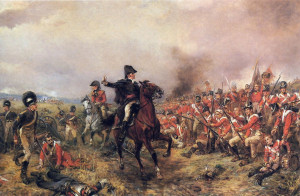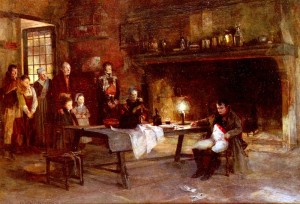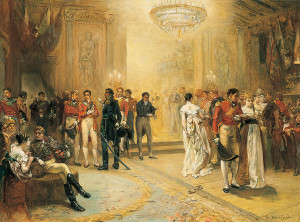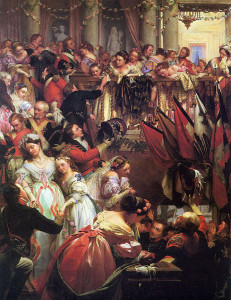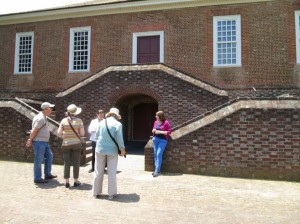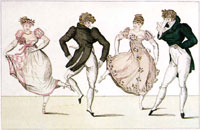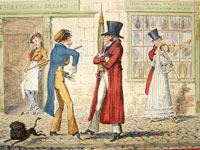 Today we welcome guest Elizabeth Cole, author of both historical and contemporary romance. Previously, she worked in bookshops, libraries, and archives…anywhere there were books to be read and cared for. Now she can be found hanging around museums, coffeeshops, and (occasionally) graveyards. In addition to her sweet Regency novellas, Elizabeth is currently writing the SECRETS OF THE ZODIAC, a series of romantic spy thrillers also set in the Regency period. Take it away, Elizabeth!
Today we welcome guest Elizabeth Cole, author of both historical and contemporary romance. Previously, she worked in bookshops, libraries, and archives…anywhere there were books to be read and cared for. Now she can be found hanging around museums, coffeeshops, and (occasionally) graveyards. In addition to her sweet Regency novellas, Elizabeth is currently writing the SECRETS OF THE ZODIAC, a series of romantic spy thrillers also set in the Regency period. Take it away, Elizabeth!
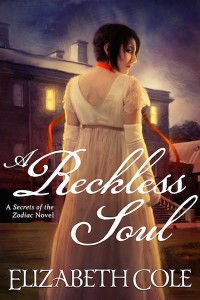 My newest novel, A Reckless Soul, is set in the Regency, just like the other books in the Secrets of the Zodiac series. Taking place in 1806, it’s the story of two determined spies—one British, one French—who must work together to defeat an enemy who threatens both of them.
My newest novel, A Reckless Soul, is set in the Regency, just like the other books in the Secrets of the Zodiac series. Taking place in 1806, it’s the story of two determined spies—one British, one French—who must work together to defeat an enemy who threatens both of them.
When researching for the story, however, I had to go back a little further. My heroine is French, and she grew up in Paris during the tumultuous period following the French Revolution. It’s a fascinating time filled with not only real history but a lot of legend and propaganda, too. One of the most interesting urban legends was the “Victims’ Ball.” What’s that, you ask?
Maybe you remember this little ghost story: One night in Paris, a young man meets a beautiful woman in a graveyard. She looks sad, wearing a red ribbon around her neck. Of course, the young man falls in love with her instantly (he’s French, after all!). He begins to court her, and every night he falls deeper and deeper in love. There’s just one problem. She never takes off the red ribbon, and soon he’s obsessed with it. So one night, he catches the end of the ribbon, unties it, and OOPS! her head falls right off. Turns out, she was the ghost of a woman beheaded by the guillotine. How tragic! How very French!
I first read that story as a child, in a collection of gruesome tales. But the tale is linked to another urban legend, that of the Victims’ Ball. According to later historians, including Thomas Carlyle in his book, French Revolution, after the Terror ended, the French aristocracy reasserted itself. One of the ways they did was to form morbid dancing societies. To be invited, you had to be “victime” of the guillotine, which meant that you had to be a close relative of someone who had died by the blade. No family martyrdom? No invite. Talk about cliquish!
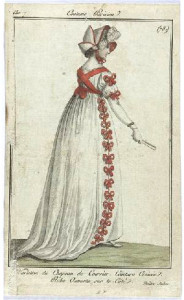 Once you had your invitation, you also had to dress properly. There was a very specific look that attendees of the bals des victimes aimed for. Women wore beautiful, filmy dresses trimmed with—you guessed it—red ribbons. Some dresses had the ribbons in a cross-back pattern over the shoulder blades. It was the sartorial equivalent of telling the executioner “x marks the spot”. And of course, ladies wore red ribbons around their necks!
Once you had your invitation, you also had to dress properly. There was a very specific look that attendees of the bals des victimes aimed for. Women wore beautiful, filmy dresses trimmed with—you guessed it—red ribbons. Some dresses had the ribbons in a cross-back pattern over the shoulder blades. It was the sartorial equivalent of telling the executioner “x marks the spot”. And of course, ladies wore red ribbons around their necks!  It was not uncommon to sport a haircut called à la victime, which was a style with a dark inspiration. Anyone with long hair had it chopped off before ascending the platform to be killed. You wouldn’t want the guillotine blade to get a lot of hair on it, of course. That’s messy and inefficient! Hence, the surprisingly modern-looking cut worn by the later imitators. I could see Miley Cyrus rocking this cut.
It was not uncommon to sport a haircut called à la victime, which was a style with a dark inspiration. Anyone with long hair had it chopped off before ascending the platform to be killed. You wouldn’t want the guillotine blade to get a lot of hair on it, of course. That’s messy and inefficient! Hence, the surprisingly modern-looking cut worn by the later imitators. I could see Miley Cyrus rocking this cut.
Now, these bals des victimes were ostensibly private, but the idea was too salacious to ignore, and reports of the balls were published in French and British newspapers. Later scholars have found little evidence for the balls, and the current conclusion it that the “Victims’ Balls” were either made up, or perhaps happened once or twice and were gossiped about a lot more than they actually happened. It seems possible some of the reports (especially in Britain) were published just to make the French look crazy and decadent…and to sell more papers. It was basically an early 19th century version of clickbait.
Since I’m a writer of fiction, I had no problem including a reenactment of the Victims’ Ball in A Reckless Soul. Whether the history of these dances is 100% accurate I couldn’t say…but the dramatic potential of such a scene is just too good to pass up. And besides, even the strangest stories often have some basis in fact…
What do you think? Do you believe such a trend could have existed in the 1790s? Have you read about this elsewhere? Would you have gone if you were allowed in? And by far the most important question…what would you want to wear?
Enter the contest to win a digital copy of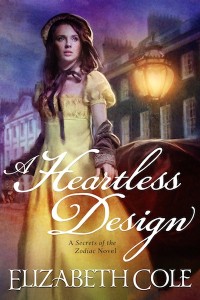 A Heartless Design, the debut novel in the Secrets of the Zodiac series–see below on how to enter. The winner will be announced Saturday morning.
A Heartless Design, the debut novel in the Secrets of the Zodiac series–see below on how to enter. The winner will be announced Saturday morning.
a Rafflecopter giveaway
